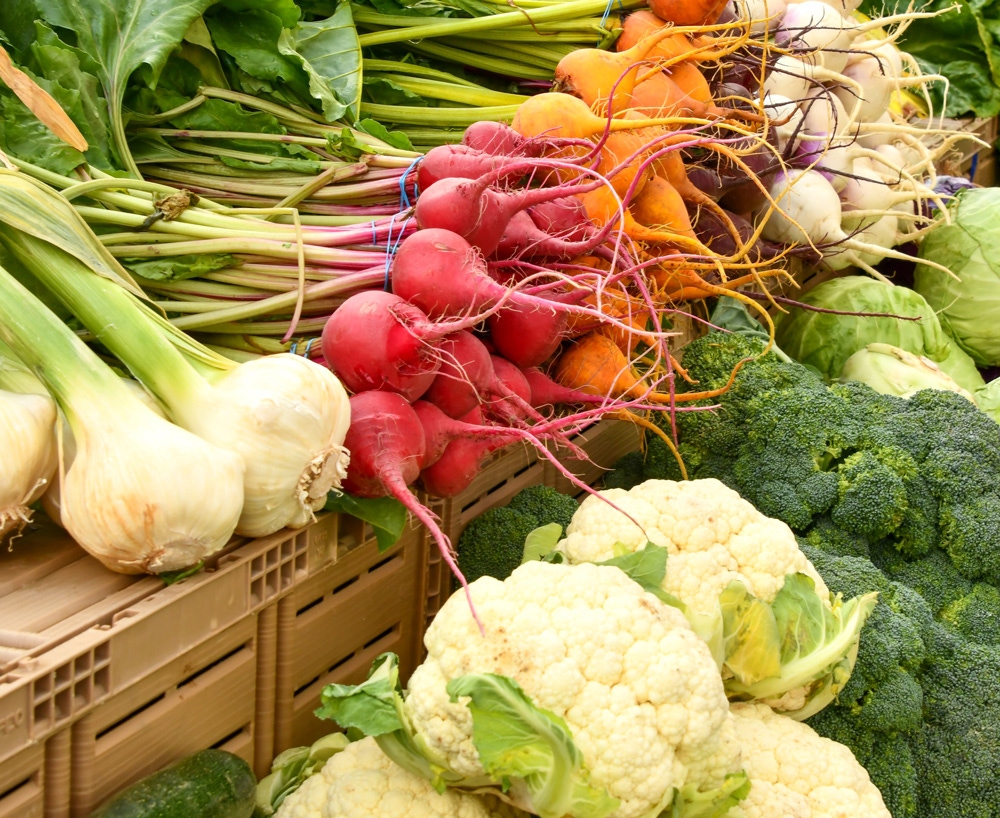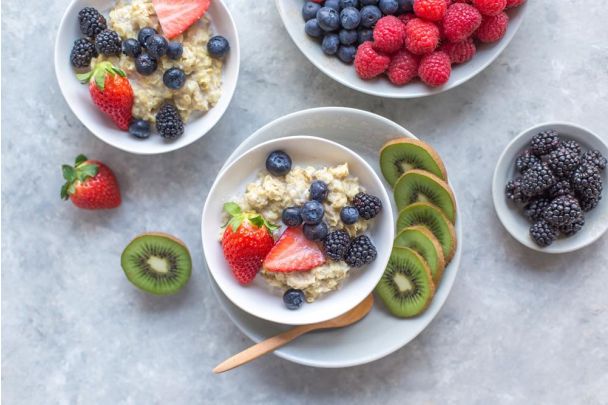In this article
When you consider that at least 70 percent of your immune system can be found in the gut, it's easy to see why supporting a healthy digestive system is important for overall wellness. And guess what? You can take a simple step on the path to better digestion starting today just by adding more fiber into your daily diet.
WHERE DOES FIBER COME FROM?
Technically, fiber is a type of carbohydrate found only in plants. So, dietary fiber sources are foods such as fruit, vegetables, whole grains, beans, legumes, nuts, and seeds.
It is also important to note that there are two main types of fiber—insoluble and soluble. Insoluble fiber, also known as roughage, is indigestible and cannot be broken down by the body. As such, it passes through your intestines mainly intact, and along the way it helps to move waste through your system and promote regular bowel movements.
Soluble fiber, on the other hand, dissolves in water and does break down in the digestive system, becoming a thick, gel-like substance. This type of fiber bypasses the small intestine and makes its way to the large intestine, where it is used by the bacteria found there. Why is that important?
FIBER IS ESSENTIALLY FOOD FOR YOUR GUT MICROBES
Remember, the human body is home to roughly 40 trillion bacterial cells, the majority of which reside in the gut. Many of these microbes are beneficial and promote good digestion and health, but there are also some neutral and harmful bacteria. The key is making sure there are more beneficial and neutral bacteria than harmful bacteria, and eating plenty of dietary fiber each day is a great way to do that.
Experts at the Sonnenburg Lab at Stanford University in California explain it this way: "Diet is a major determinant of which microbes flourish in the microbiota. Dietary microbiota-accessible carbohydrates (MACs), the main component of dietary fiber, serve as the primary metabolic input for the gut microbiota."
In other words, the food you eat has a big impact on the bacteria in your gut. And if you asked your friendly gut microbes, they would tell you that the good stuff in fiber is their favorite thing to eat because it helps them thrive and multiply. The end result is a well-balanced, diverse gut flora population, which in turn supports not just good digestion but the health of your whole body. (You can read more about how gut bacteria supports your health.)

HOW DOES FIBER BENEFIT DIGESTIVE HEALTH?
- Soluble fiber absorbs water and adds bulk to your stool. As a result, research has shown that a high-fiber diet may improve stool consistency and frequency. Why? Because well-formed stool is more easily passed through the intestines, which helps to keep bowel movements regular.
- Fiber shortens gastrointestinal transit time. Studies like this one show that fiber is beneficial to digestive health because it helps to "keep things moving" and prevents waste from building up in the colon, where it may cause damage.
- Fiber helps protective gut bacteria flourish. We touched on this already, but it's worth repeating that your good bacteria love fiber. In this study, a diet high in fiber was linked to greater numbers of beneficial Bifidobacteria and Lactobacilli in the gut.
DID YOU KNOW GUT HEALTH CAN BE PASSED ALONG TO YOUR CHILDREN (AND THEIR CHILDREN?)
A telltale study conducted by scientists at the Stanford University School of Medicine actually showed the effects of a low-fiber diet on several generations of a species.
Researchers started with two groups of mice, both of which had been raised in a bacteria-free environment, meaning they had no microbial inhabitants of any kind in their bodies. They then transferred human gut bacteria into the guts of the mice, and each group was fed either a high-fiber diet or an extremely low-fiber diet.
Results showed that the mice with barely any fiber in their diets experienced a drastic decrease in the number and type of microbes present in their guts. And four generations later, the lack of fiber caused “irreversible losses” in terms of gut microbiota—both in number and diversity. At that point, just adding more fiber to the diet was not enough to undo the effects.
According to study authors, when an entire population suffers such a broad-scale loss of important gut microbes, it may never recover. This is especially relevant today in the United States and other developed countries where a Western pattern diet (one dominated by refined sugars, refined vegetable oils, fatty meats, and salt but very low in fiber) has become the standard.

HOW MUCH FIBER SHOULD YOU BE GETTING IN YOUR DAILY DIET?
According to the National Institutes of Health, men should aim for about 38 grams of fiber a day, while women should aim for about 25 grams. Unfortunately, most Americans only consume about 14 grams of fiber a day on average.
How can you boost your daily fiber intake? Experts at the Johns Hopkins University School of Medicine recommend using a little creativity to help you sneak more fiber into your daily diet. Here are their suggestions:
- Get creative with beans: Try legumes and lentils in different ways. These are amazing high-fiber plant foods that you can add to anything. Think about using these as a substitute in place of meat (think black bean burger and so much more), added to salads, soups, eggs, mashed in dips or as a spread.
- Trade in your white flour: Let’s face the facts that white four has almost no fiber. The good news is that there are some good substitutes. Check out oat flour, almond flour, brown rice flour, coconut flour, teff flour, buckwheat flour, and chickpea flour. These can’t be used as equal substitutes for white flour in any recipe, but look for recipes that include these flours to increase your fiber intake.
- Try some new starches: Some people with diabetes are already avoiding rice, pasta, breads, or cereals because of the carbs, but it’s important to include some starches that have fiber. Your body still needs healthy carbs. Think about oats, teff, bulgur, barley, quinoa, farro, wild rice, buckwheat, millet, and even popcorn.
- Snack on higher-fiber foods: Too often for snacks, we think of the usual suspects: crackers, chips, or sweets that are packaged and marketed as snacks. Instead look for real foods: fruits, vegetables and dip, nuts, or seeds. Plan ahead and make these foods your snacks.
- Try some new forms of pasta: Spend some time in the pasta aisle reading labels and you will quickly learn that not all pastas are created equal. Check out some of the higher-fiber pastas including those made from whole grain, black beans, lentils, brown rice, or chickpeas. Don’t forget that spiralized vegetables also make a great pasta substitute.
- Add nuts and seeds to almost anything: Most nuts and seeds are low in carbs and contain some fiber. Work on creative ways to add these to your daily diet including whole or chopped nuts and seeds to cereals, salads, soups, smoothies, yogurt, or dips. Nut and seed butters are a great choice for a healthy spread.
- AVOCADOS: Yes, this is technically a fruit but lower in carbs and a good source of fiber. Add sliced avocado to anything including eggs, salad, toast, sandwiches, smoothies, dips, and use in place of mayo or sour cream.
- Bump up the veggies: It’s ideal to say we eat vegetables with lunch and dinner. It’s more important to look at the amount. While not all vegetables are equal in fiber, increasing your variety and intake overall will help. The technical serving size of vegetables is ½ cup cooked or 1 cup raw. A good starting goal is anything more than you are eating now but in the long run think about 5-8 servings of vegetables per day.
WHAT ABOUT FIBER SUPPLEMENTS?
In addition to eating more fiber-rich foods, which remains the best way to increase your dietary fiber intake, many people choose to take a daily fiber supplement. In studies like this one, fiber supplements have been shown to help increase fiber consumption and promote digestive health and regularity. However, it is important to choose a high-quality fiber supplement with a balanced ratio of both soluble and insoluble fiber.
Renew Life Daily Digestive Prebiotic Fiber is made with a mix of soluble and insoluble fiber and contains soothing fennel.* The Non-GMO Project Verified supplement combines organic flax seed, organic oat fiber, and organic fennel seed to help relieve occasional constipation, gas, and bloating.†*
HOWEVER YOU ADD MORE FIBER, YOUR GUT WILL THANK YOU
We know from countless studies that a well-balanced gut microbiome plays a key role in promoting optimal digestion and wellness, and that consuming adequate amounts of dietary fiber is linked to healthy gut flora.
Pay attention to nutrition labels, and increase your fiber intake slowly with one high-fiber snack or side dish a day. If you prefer supplements, start with the lowest daily dosage, since adding too much fiber too quickly may result in occasional gas and bloating for some people. A gradual approach will give your digestive system time to adjust to the change so you can ultimately benefit from everything fiber has to offer.
†Contains fennel seed, traditionally used to relieve gas and bloating











Share: